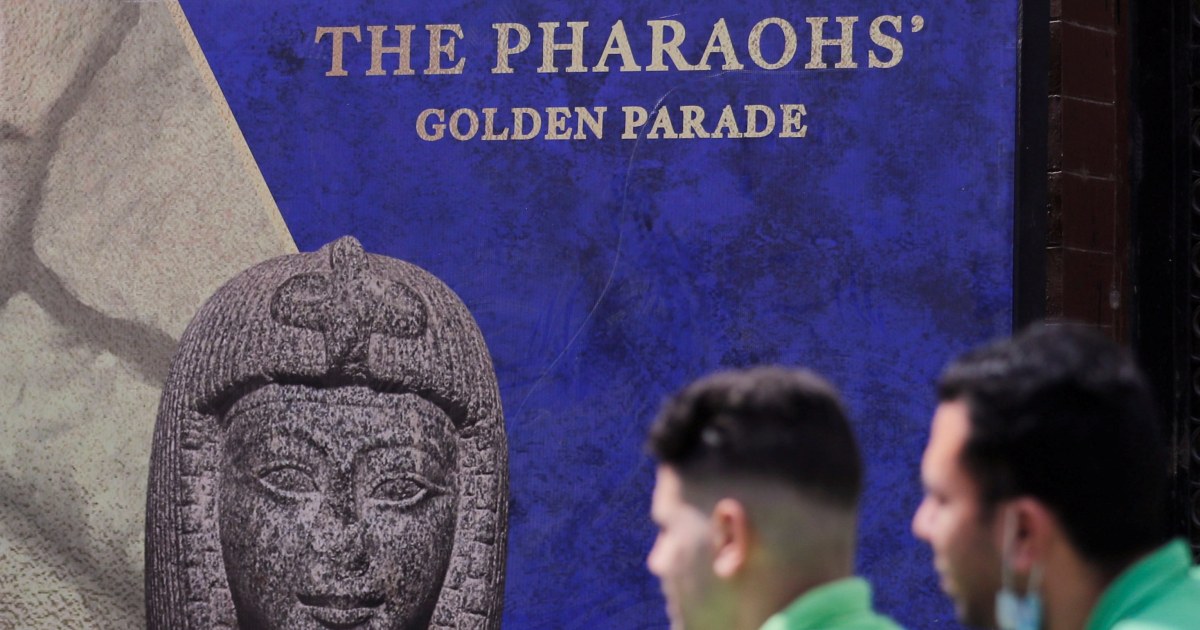CAIRO – Some blame the “curse of the pharaohs” for a number of unfortunate incidents in Egypt in recent weeks, including the giant ship that blocked the Suez Canal for about a week until it was liberated on Monday.
Nevertheless, many were expected to turn on their TVs for the grand parade of 22 ancient Egyptian royal mummies as they were relocated to the capital Cairo on Saturday. Officials have urged people to stay off the streets due to coronavirus restrictions.
Authorities have closed roads along the Nile for the extensive royal march called the Golden Parade, which is designed to spark interest in the rich African collection of antiquities in North Africa as tourism has come to a near halt due to the coronavirus pandemic.
The convoy transported 18 kings and four queens, mostly from the ancient era of the New Kingdom, in shock absorber vehicles and specially designed capsules filled with nitrogen to ensure its protection.
The national treasures traveled about 3 km from the Egyptian Museum, which opened in Cairo’s Tahrir Square in 1902, to their new home in the National Museum of Egyptian Civilization in Fustat – the site of Egypt’s capital under the Umayyad. dynasty was after the Arab conquest.
The relocation of the mummies has rekindled the discussion of a pharaoh’s curse, especially on social media, after the ship blocked the Suez Canal, a train crash killed dozens last month and a building in central Cairo collapsed .
“Death will come on fast wings for those who disturb the king’s peace,” read the warning on Tutankhamun’s tomb before British archaeologist Howard Carter opened it in 1922.
Members of his expedition later succumbed to freak accidents and death, fueling the myth of the curse, although archaeologists and scientists now say they were probably linked to exposure to dust and germs in the sealed caves.
Egyptian archaeologist Zahi Hawass has dismissed the rumors.
“Before the mummies walked the streets of Cairo today, things happened in Egypt: the boat in the Suez Canal, also the trains had an accident and a building collapsed. Everyone says it’s the mummy’s curse, but I say there is no curse of the mummy, “he told NBC News.” The curse is good for TV, for movies and newspapers, but it’s not true. There is no curse at all. “
Instead, Hawass said locals and foreign tourists themselves can see the ‘secrets’ each mummy possesses once they are exhibited.
“The parade is very important not only for Egypt but also for the whole world because 22 kings will walk like magic in the streets of Cairo,” he added.
Download the NBC News app for recent news and politics
Archaeologists discovered the mummies in two groups in 1881 and 1898 in the complex of mortuary temples of Deir Al Bahari in Luxor and in the nearby Valley of the Kings.
The oldest mummy in the group is that of King Seqenenre Tao, the last king of the 17th Dynasty, who ruled in the 16th century BC and presumably had a violent death.
The parade also features the mummies of Ramses II, Seti I and Queen Ahmose-Nefertari, who were responsible for military expeditions, trade networks and the construction of large monuments and works of art.
“By doing so, with great pomp and circumstance, the mummies are getting their sense,” Salima Ikram, an Egyptologist at the American University in Cairo, told Reuters. “These are the kings of Egypt, these are the pharaohs. And so this is a way of showing respect.”
Charlene Gubash reports from Cairo and Adela Suliman from London.
Raf Sanchez and Reuters contributed.


